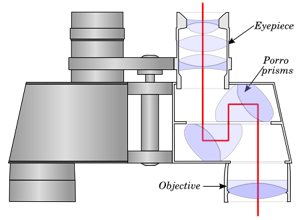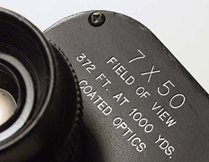Binoculars

Binoculars are also known as binocular telescopes. They are two telescopes mounted next to each other. Their alignment allows you to see a three-dimensional view of whatever you are observing.
How They Work
Binoculars work by using refraction, which is how light bends when it passes through a medium (in this case, it would be glass).
The lens closest to the object you are viewing is called the objective lens. The main function of this lens is to gather light for viewing the image. Once a view of the image is captured, it is focused behind the lens.
At this point, the image is upside-down (this is because the lenses used are convex). To correct this, the image is passed to a set of prisms, which rotate the image back to its correct orientation. The image is then sent through an eyepiece, which magnifies the image and puts it into focus for you to see.
Parameters

Most binoculars are marked with a set of numbers next to the viewing lenses. The first set of numbers you see should be marked with an "x". The first number in this set is the magnitude or power. This will tell you how much the image you are viewing will be enlarged. The second number is the aperture, which tells you the diameter (in millimeters) of the lenses farthest away from you. This helps to determine the field of view.
You may also see an additional number below these numbers. This is the field of view. This number is how much you can see at any one point through the binoculars. This can be expressed in feet per 1000 yards (as shown), or in degrees (1 degree = 52 ft/1000 yards). In this case, if you are 1000 yards away from an object, you will see 372 feet of the object at any one point in time.
Finding the Right Binoculars
There are several things you should consider when looking for the right binoculars:
- high aperture - The aperture is the diameter of the lenses farthest from you. The higher the aperture, the more light the binoculars can collect to get you a good view of the object.
- high optical quality - Low quality lenses can show imperfections, which can result in an improper view of the object. Usually, the higher the price of the binoculars, the better the optical quality.
- magnification - You need to find a balance between magnification and the weight of the binoculars. A magnification of 7 for example may give you less detail than a 10, but the 10 may fatigue your arms and shoulders during prolonged use.
- exit pupil - The exit pupil is the diameter of light you will see from the eyepiece (this value is determined by dividing aperture by magnification). Your eye will only see what is allowed in through the pupil. A larger exit pupil than the diameter of your pupil will be wasted light. Young adults typically should use around 7mm, while adults over 30 can get away with a smaller exit pupil measurement (those over 30 lose 1mm every 10 years).
What You Can See
Even though the magnification is typically low, there are still many things you can see with binoculars:
- Earth's moon - you can get an excellent view of the moon's craters and mountain ranges. One interesting item to look for is the terminator. Known as the separation between the light and dark sides, this is the place to find a stark contrast in the moon's features.
- planets - you can see Jupiter and its four moons, as well as Neptune and Uranus. In this case, a star chart comes in handy.
- nebulae - you can look for the Orion Nebula (M42). Located near Orion's sword, this will show up as a glowing, hazy patch.
- galaxies - check out the spiral-shaped Andromeda Galaxy (M31). This galaxy is located within the constellation Andromeda, below the constellation Cassiopeia.
References
Please visit our references page.




